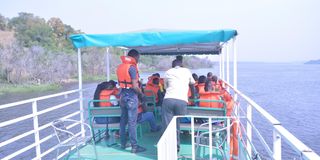Will oil power tourism fortunes?

Out of the 9,200 tourist arrivals at Murchison Falls National Park in 2021, at least 6,200 were domestic tourists. PHOTO | PAUL MURUNGI
What you need to know:
- The discovery of oil and gas resources has the Albertine Graben area a new dimension with the road infrastructure now upgraded from marram to tarmac.
Ugandans in both mainstream and social media have raised environmental and social concerns with some suggesting that by the time Uganda starts production, oil and gas will have no value because of the shift fromVisiting Murchison Falls National Park is highly rewarding; first, because of its iconic anchor point - the thunderous Murchison waterfalls cascading over the mighty River Nile; and because it’s the country’s largest and oldest conservation area spanning 4,000 square kilometres.
However, the discovery of oil and gas resources has given the park a new dimension with the road infrastructure now upgraded from marram to tarmac.
From a personal experience, the beauty of the new infrastructure is gives you many choices from a spending a night in Masindi Town and waking up to drive for just an hour Paraa bridge, where much of the excursions within the park begin.
It’s not just about the roads. Previously crossing the Paraa point of Victoria Nile had to be on a ferry. However, the new projects, necessitated construction of a bridge that now connects from one end to the other.
Total Energies, which will undertake oil drilling in the national park, is required to use environmentally friendly technology to develop the existing oil resources and have co-existence with the environment and tourism.
Although tourism has been one of the hard-hit sectors of the economy due Covid-19, oil and gas has been viewed as one of the sectors that will offer an excellent opportunity to revive tourism and set it on a speedy recovery to achieve and surpass pre-Covid-19 levels.
Before Covid-19 set in, tourist arrivals had been projected to grow to 1.6 million visitors by the Ministry of Tourism. However, the freezing of economy for close to two years and closure of borders left the sector on its knees with an estimated loss of up to $1.06b (Shs3.9 trillion) in tourism receipts, according to Uganda Tourism Board.
However, the economy has since been reopened and data indicates, a slow but albeit good recovery.
Data obtained from Murchison Falls, Kibale Forest, and Semliki National Park, which fall in the western arm of the rift valley, shows the last two month of 2021 were the busiest.
For instance, Murchison Falls National Park, Uganda’s oldest and largest conservation area, registered 9,200 tourist arrivals in November, out of which 6,200 were domestic tourists.
The numbers might be related to oil and gas activities in the region, which, in a recent newsletter, Susan Kamugasa and Liz Adukule from Uganda Petroleum Authority Uganda, said tourism recovery on the back of oil and gas development is, especially true since the Albertine Graben is a biodiversity hotspot with more endemic species than any region in Africa.
This is attributed to the landscape’s micro-climate, diverse and healthy ecosystems such as water bodies, savanna grasslands, tropical rain forests, cultural sites, and protected areas. The Graben remains a number one destination for tourism in Uganda.
To put this in perspective, tourist sites within the Albertine Graben stretch from Murchison falls National Park, to the cultural sites within Hoima District, rift valley and then to Kibale conservation area in the south with a number of crater lakes, hot springs and a biodiversity of wild animals, rare species of birds and dense rain forests.
In fact, it is envisaged oil facilities are also expected to attract tourists within the area.
However, the success of the tourism sector largely depends on good infrastructure and this is exactly what the oil infrastructure is offering.
Key among the supporting oil infrastructure is Uganda’s second international airport being constructed in Kabaale, Hoima district, Bugungu airstrip in Buliisa district and other 700 kilometres of critical oil roads and two bridges that are complete across the Albertine region and the crude pipeline districts.
The Petroleum Authority estimates putting in place the infrastructure required to produce and commercialise the country’s Oil and gas resources, is expected to bring in investments of between $15b and $20b into the country in the next three to five years.
In addition, an estimated 160,000 direct, indirect, and induced jobs will be created because of these investments.
It is also envisaged that the oil and gas sector activities will have the potential to attract an influx of about one million people into the Albertine region during the construction phase, out of which 10,000 are estimated to be expatriates.
Such increased economic activity is expected to boost tourism and the sector will leverage on the oil and gas supporting infrastructure to grow its numbers.
Infrastructure
A number of supporting infrastructure such as upgrade of roads, Bugungu and Pakuba airfields have been put in place and will be important in easing access to various tourist destinations within the region,
Jowet Matsiko, a tour operator with Gild Tours, says Murchison Falls National Park has been battling with narrow roads, which sometimes get muddy during the rainy season.
However, with the new infrastructure and capital flow in the oil region, she believes, there is going to be a boost in opportunities for even locals to participate.
Previously, Uganda has been a centre of adventure tourists, but there is a shift with trends pointing to new areas such as oil, says Amos Wekesa, a major player in the tourism sector.
Expatriates, he says, associate with high quality services ranging from accommodation, transport and catering, which provide countless opportunities.




